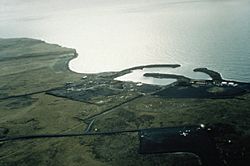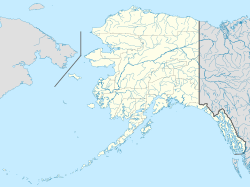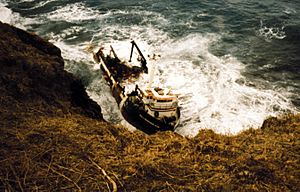St. George, Alaska facts for kids
Quick facts for kids
St. George
Anĝaaxchalux̂
|
|
|---|---|

Aerial view of St. George harbor
|
|
| Country | United States |
| State | Alaska |
| Census Area | Aleutians West |
| Incorporated | September 13, 1983 |
| Area | |
| • Total | 182.31 sq mi (472.17 km2) |
| • Land | 34.78 sq mi (90.08 km2) |
| • Water | 147.52 sq mi (382.09 km2) |
| Elevation | 197 ft (60 m) |
| Population
(2020)
|
|
| • Total | 67 |
| • Density | 1.93/sq mi (0.74/km2) |
| Time zone | UTC-9 (Alaska (AKST)) |
| • Summer (DST) | UTC-8 (AKDT) |
| ZIP code |
99591
|
| Area code | 907 |
| FIPS code | 02-65800 |
| GNIS feature ID | 1419161 |
St. George is a small city in Alaska, United States. It's also known as Anĝaaxchalux̂ or Sangiurgiix̂ in the local Aleut language. St. George is the main town on St. George Island, which is part of the Pribilof Islands. This group of islands is located in the Bering Sea. In 2020, only 67 people lived there.
Contents
History of St. George Island
St. George Island was found by a person named Gavriil Pribylov on June 25, 1786. He was looking for places where northern fur seals had their babies. The island was named after Pribylov's ship, which was called the St. George. It was the first island in the Pribilof group to be discovered.
The only church on the island is St. George Church. It was built in 1935 and is an Eastern Orthodox Church.
In 1996, a crab-fishing vessel called the All American got stuck on the island. Luckily, no one was hurt.
Geography and Climate
St. George is located in the Bering Sea. The city covers about 182 square miles (472 square kilometers). Most of this area is water, with about 34.8 square miles (90.08 square kilometers) being land.
The city has an airport that offers flights to nearby islands like St. Paul Island Airport and Unalaska Airport. These flights are provided by Grant Aviation. You can also fly to Anchorage from St. George with Alaska Central Express.
Climate in St. George
St. George has a cool and damp climate. The weather often has fog and strong winds. Temperatures usually stay cool throughout the year, even in summer. Winters are cold but not extremely harsh.
Population Changes
| Historical population | |||
|---|---|---|---|
| Census | Pop. | %± | |
| 1880 | 92 | — | |
| 1890 | 93 | 1.1% | |
| 1910 | 90 | — | |
| 1920 | 138 | 53.3% | |
| 1930 | 153 | 10.9% | |
| 1940 | 183 | 19.6% | |
| 1950 | 187 | 2.2% | |
| 1960 | 264 | 41.2% | |
| 1970 | 163 | −38.3% | |
| 1980 | 158 | −3.1% | |
| 1990 | 138 | −12.7% | |
| 2000 | 152 | 10.1% | |
| 2010 | 102 | −32.9% | |
| 2020 | 67 | −34.3% | |
| U.S. Decennial Census | |||
St. George first appeared in the U.S. Census in 1880. Back then, it was a village with 92 people. Most of them were Aleut, who are native to Alaska. Over the years, the population has changed quite a bit. The city officially became a city in 1983.
In 2000, there were 152 people living in St. George. Most residents were Alaska Native, making up about 92% of the population. The rest were White. There were 51 households, and many of them had children living there. The average household had about three people.
The median age in the city was 33 years old. This means half the people were younger than 33 and half were older. The average income for a household was about $57,083 per year.
Education for Kids
The Pribilof Island School District used to serve St. George. In 2004, students in grades 9-12 could take classes using video calls. This meant they could learn from home. Another option was to go to a boarding school like Mt. Edgecumbe High School.
In 2017, the St. George School closed down because there weren't enough students. Now, the school district offers a special program for students in kindergarten through 10th grade. This program lets students learn from home through a correspondence (mail-based or online) system.
Wildlife on St. George Island
St. George Island is very important for wildlife. It is a major breeding spot for a special bird called the red-legged kittiwake. More than 75% of all known red-legged kittiwakes in the world have their babies here.
In 2016, a brand new type of beaked whale was found near the island. It was named Berardius beringiae. This shows how unique the marine life around St. George Island is. The island itself is part of the Bering Sea Volcanic Province, which means it was formed by volcanoes.
See also
 In Spanish: St. George (Alaska) para niños
In Spanish: St. George (Alaska) para niños




